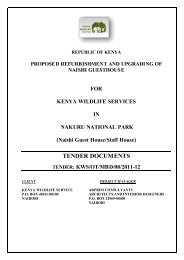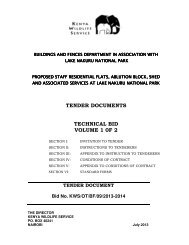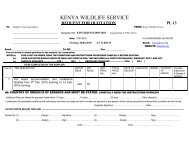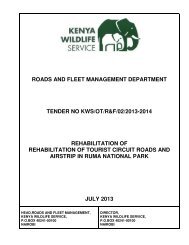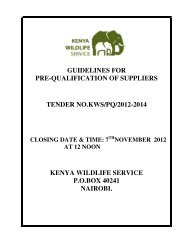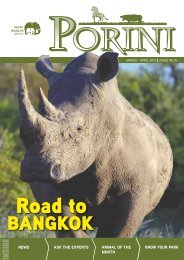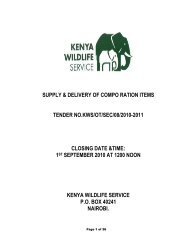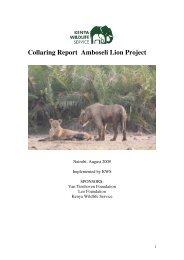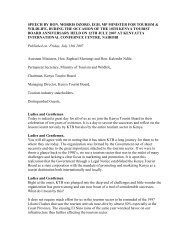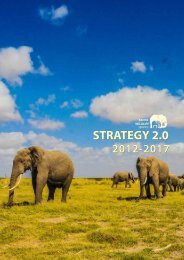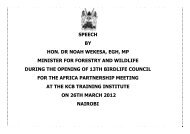Porini Issue No.5 April-May 2012 - Kenya Wildlife Service
Porini Issue No.5 April-May 2012 - Kenya Wildlife Service
Porini Issue No.5 April-May 2012 - Kenya Wildlife Service
- No tags were found...
Create successful ePaper yourself
Turn your PDF publications into a flip-book with our unique Google optimized e-Paper software.
Ask the ExpertIn a struggle to surviveSea turtle populations are threatened throughout the world, and <strong>Kenya</strong> is no exception.Due to their unique ecology andmigratory nature, the myriad ofthreats sea turtles faces has led todrastic global population decline. PORINIspoke to Dr Charles Musyoki, a SeniorScientist at <strong>Kenya</strong> <strong>Wildlife</strong> <strong>Service</strong>, aboutthe animals’ conservation strategy.How many species of sea turtles arefound in <strong>Kenya</strong>?There are five species; the green turtle(Chelonia mydas), hawksbill turtle(Eretmochelys imbricata), olive ridley turtle(Lepidochelys olivacea) nest and foragewhile the loggerhead (Caretta caretta) andthe leatherback (Dermochelys coriacea)use <strong>Kenya</strong>’s waters as migratory routesand foraging grounds.Sea turtle populations are threatenedthroughout the world, and <strong>Kenya</strong> is noexception. The world population of seaturtles is estimated to have declined by 80per cent over the last 50 years, yet theyplay a critical role in the marine ecosystemand their presence is an indicator of thehealth of the marine environment. The seaturtle is thus one of the flagship speciesfor conservation, protection, research aswell as a tourism attraction in <strong>Kenya</strong>.What threats and challenges face seaturtle conservation?The main challenges that face sea turtleconservation include incidental captureduring fishing, coastal development andloss of habitat, and illegal exploitationfor their meat, oil and eggs. In addition,there is a lack of comprehensive dataand information on their population size,nesting and foraging sites, migration aswell as mortality and threats. The weightof the challenges facing the conservationof sea turtles is globally recognised, with<strong>Kenya</strong> having signed various internationaland regional agreements on sea turtleconservation and management.How can the recovery of sea turtles beachieved in <strong>Kenya</strong>?Effective management and recovery of<strong>Kenya</strong>’s sea turtle population can onlybe achieved through implementation ofa national strategy that was officiallylaunched in early 2011. This links intoregional and international initiatives toprotect nesting beaches and criticalforaging habitats from degradation,eliminate illegal harvesting and trade insea turtles and their products, mitigatefishing impacts and enhance collaborativeparticipation of local communities andother stakeholders in conservation.How will this strategy be implemented?The strategy is intended to guide effortsto conserve and manage sea turtles andtheir habitats in <strong>Kenya</strong>. The main tools tobe used towards its realisation includeadvocacy, communication, education,public awareness, targeted research andmonitoring and threat mitigation.This strategy builds on ongoingefforts and initiates changes that will addvalue to sea turtle conservation efforts.It is also aligned to international andregional conservation conventions andagreements. The strategy also contributestowards the realisation of Vision 2030,which recognises tourism as a majorsector towards economic empowermentand to the increasing international valueof eco-tourism in relation to speciesconservation.Besides <strong>Kenya</strong> <strong>Wildlife</strong> <strong>Service</strong> (KWS),which other institution is involved in theconservation of the sea turtles?KWS is working with the FisheriesDepartment (FiD). Both institutions havebeen mandated to conserve and managesea turtles and their habitats in <strong>Kenya</strong>’sterritorial waters.These organisations endeavour tocurb threats facing sea turtles, enlistingsupport in conservation, establishinginfrastructure and developing humancapacity. This progress has been madepossible by support from the Governmentof <strong>Kenya</strong>, local and international researchand conservation partners.KWS and FiD appreciate the inputand efforts of all stakeholders in theconservation and management of seaturtles. Successful implementation ofthe strategy will ensure that the speciespopulations and habitats are conserved.This requires the participation andcollaboration of all stakeholders: thegovernment, donors, the private sector,sea turtle conservation organisations andthe community.5



